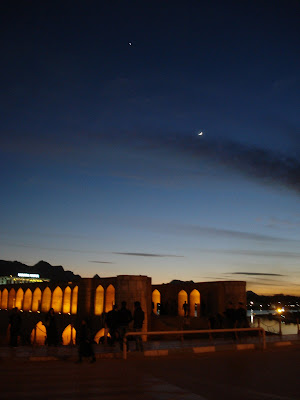Coup
The National Intelligence Estimate which has considerably relieved the strain on Iran’s nuclear program was not entirely new. While IAEO Director General Mohamed ElBaradei wrote in October 2007 that there is no evidence that Iran was working actively to build nuclear weapons, largely confirming NIE, Seymour Hersh reported already one year ago about clandestine results of the C.I.A. activities which were perceived in the White House with hostility. He wrote in The New Yorker on November 27, 2006 (!):
“The Administration’s planning for a military attack on Iran was made far more complicated earlier this fall by a highly classified draft assessment by the C.I.A. challenging the White House’s assumptions about how close Iran might be to building a nuclear bomb. The C.I.A. found no conclusive evidence, as yet, of a secret Iranian nuclear-weapons program running parallel to the civilian operations that Iran has declared to the International Atomic Energy Agency. (The C.I.A. declined to comment on this story.)
The C.I.A.’s analysis, which has been circulated to other agencies for comment, was based on technical intelligence collected by overhead satellites, and on other empirical evidence, such as measurements of the radioactivity of water samples and smoke plumes from factories and power plants. Additional data have been gathered, intelligence sources told me, by high-tech (and highly classified) radioactivity-detection devices that clandestine American and Israeli agents placed near suspected nuclear-weapons facilities inside Iran in the past year or so. No significant amounts of radioactivity were found.
A current senior intelligence official confirmed the existence of the C.I.A. analysis, and told me that the White House had been hostile to it.”
Bush was not delighted or so. He was annoyed. The article was published a week after Hersh's interview with CNN, where he mentioned the secret C.I.A. report.
So, the same evidence or lack of it was present in late autumn 2006, but preparations for war went on. Several aircraft carriers were located in the Arabian Gulf, and warmongering rhetoric culminated in October. When I left Kuwait in May, I felt the situation being at least as or even more dangerous in the Middle East as just before the Iraq war in 2003.
Hersh asked, in his article in The New Yorker, the question: Is a damaged Administration less likely to attack Iran, or more? The damage for the US Administration is now even greater. An imminent attack of Iran, that is the general appraisal in Monday morning’s newspapers, has become rather unlikely.
Irony of history has it that the former U.S. Ambassador to the United Nations, John Bolton, talks about a “quasi-Putsch” of the intelligence. Fifty-four years after Operation Ajax.
“The Administration’s planning for a military attack on Iran was made far more complicated earlier this fall by a highly classified draft assessment by the C.I.A. challenging the White House’s assumptions about how close Iran might be to building a nuclear bomb. The C.I.A. found no conclusive evidence, as yet, of a secret Iranian nuclear-weapons program running parallel to the civilian operations that Iran has declared to the International Atomic Energy Agency. (The C.I.A. declined to comment on this story.)
The C.I.A.’s analysis, which has been circulated to other agencies for comment, was based on technical intelligence collected by overhead satellites, and on other empirical evidence, such as measurements of the radioactivity of water samples and smoke plumes from factories and power plants. Additional data have been gathered, intelligence sources told me, by high-tech (and highly classified) radioactivity-detection devices that clandestine American and Israeli agents placed near suspected nuclear-weapons facilities inside Iran in the past year or so. No significant amounts of radioactivity were found.
A current senior intelligence official confirmed the existence of the C.I.A. analysis, and told me that the White House had been hostile to it.”
Bush was not delighted or so. He was annoyed. The article was published a week after Hersh's interview with CNN, where he mentioned the secret C.I.A. report.
So, the same evidence or lack of it was present in late autumn 2006, but preparations for war went on. Several aircraft carriers were located in the Arabian Gulf, and warmongering rhetoric culminated in October. When I left Kuwait in May, I felt the situation being at least as or even more dangerous in the Middle East as just before the Iraq war in 2003.
Hersh asked, in his article in The New Yorker, the question: Is a damaged Administration less likely to attack Iran, or more? The damage for the US Administration is now even greater. An imminent attack of Iran, that is the general appraisal in Monday morning’s newspapers, has become rather unlikely.
Irony of history has it that the former U.S. Ambassador to the United Nations, John Bolton, talks about a “quasi-Putsch” of the intelligence. Fifty-four years after Operation Ajax.



Comments